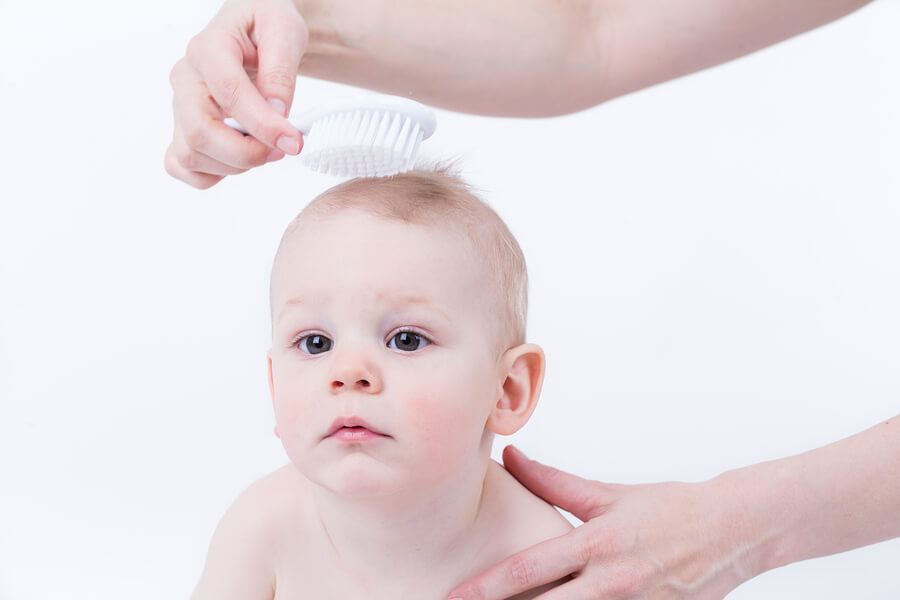What Is Cradle Cap?

Cradle cap appears in the first months of a baby’s life and is the equivalent of dandruff in adults. Usually, it’s small scales of yellowish or whitish color on the scalp of the child.
Occasionally, cradle cap may appear on the eyebrows, eyelashes, nose, behind the ears or even on other areas of the baby’s face and body.
T he causes of the appearance of cradle cap have nothing to do with their diet. For this reason, today we’re going to dedicate this article to discovering more about the subject.
What Are the Causes of Cradle Cap?
Cradle cap appears as a result of excessive production of fat by the sebaceous glands in the first months of the child‘s life.
More explicitly, it’s related to the persistence of maternal hormones in the baby’s body after birth. These hormones stimulate the sebaceous glands and produce an excessive amount of sebum on the surface of the baby’s skin.
As the baby grows, the hormone concentration decreases. This leads, gradually, to the disappearance of cradle cap in the months after birth.
Cradle cap isn’t contagious and isn’t related to any lack of hygiene. Also, you should avoid excessively aggressive products that can aggravate this type of dermatitis.

How to Treat Cradle Cap
In general, cradle cap doesn’t require treatment and usually disappears on its own over time.
However, there are moms who prefer to get rid of these scabs to improve their little one’s appearance. Here are some of the most common solutions:
1. Wash the Baby’s Hair with Mild Shampoo
In case cradle cap is present on the scalp, wash the baby’s head with a suitable shampoo to remove excess fat. It isn’t essential that you use shampoo every day, as it can dry the delicate skin of the baby. A wash every two or three days is enough.
2. Apply Natural Oils
It’s possible to combat cradle cap by applying one or two drops of sweet almond oil. This helps to soften their scalp so that it comes off more easily. For best results, let the drops act on the areas where the crust is visible before bath time.
You should keep in mind that some allergists advise against the use of almond oil due to the risk of allergy caused by nuts. However, you can substitute it with olive oil or Argan oil.
“Cradle cap may appear on the eyebrows, eyelashes, nose, behind the ears or even on other areas of the baby’s face and body.”
3. Give Them a Gentle Massage
Carefully applying a massage to the scalp or affected area of the body for a few minutes with an adapted oil is very positive.
Next, we recommend brushing the scalp to prevent the scabs from splitting and to not have to eliminate them with nails.
4. Brush with a Soft Bristle Comb
Using a soft baby brush helps eliminate scabs. Of course, it’s essential to brush the scalp with extreme softness and sensitivity to not further irritate the skin.
If you want to avoid any risk of infection, we recommend that you don’t remove the scabs that don’t peel by themselves and use a soft bristle brush.

What Can You Do if the Problem Persists?
It’s always better to opt for natural solutions to overcome cradle cap. However, if after 15 days of care, you don’t notice any improvement, we recommend that you consult a doctor.
This is advisable if you notice that red patches form on other parts of the body or that the baby shows signs of inflammation.
If, on the other hand, the scabs are infected or inflamed, the doctor may prescribe the application of an antifungal cream or a local antibiotic to reduce the risk of infection.
In short, cradle cap is a common and benign condition. However, it can reappear, even when treated properly, because the glands continue to produce too much sebum for several weeks. With vigilance and adapted care, you can slow its development until it completely disappears.
All cited sources were thoroughly reviewed by our team to ensure their quality, reliability, currency, and validity. The bibliography of this article was considered reliable and of academic or scientific accuracy.
- Dalmau Arias J, VILA AT, Puig Sanz L. Dermatitis Seborreica. Vol 18. Haymarket; 1987.
- Ridao M, Redondo I. Dermatitis atópica en Pediatría integral: programa de formación continuada en Pediatría Extrahospitalaria. 2012; XVI (3): 213-220.
- Zambrano A. Dermatitis seborreica. Monografía, Schering, 1990.